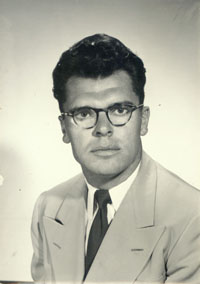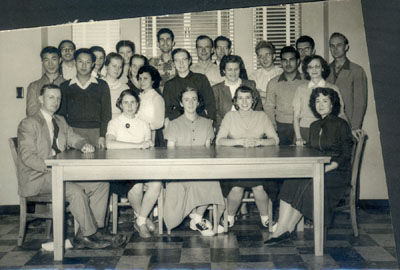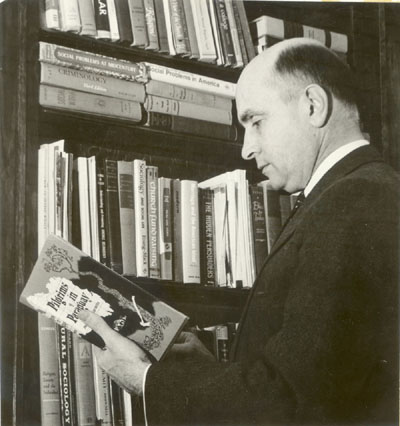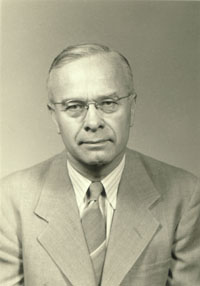
Leo Driedger as a Bethel senior in 1954
 December 2004
vol. 59 no. 4
Back to Table of Contents
December 2004
vol. 59 no. 4
Back to Table of Contents
Leo Driedger is Professor Emeritus of Sociology at the University of Manitoba, where he taught for 35 years. He is a Fellow of the Royal Society of Canada and was recently recognized by the Canadian Sociology and Anthropology Association (1999), and the Anabaptist Sociology and Anthropology Association (2003). For more than 20 years, Driedger has served on MCC boards (Manitoba, Canada, International), which has taken him to 100 countries.
Adapted from a presentation given for the Bethel College Alumni Association on May 22 2004. The author was honored as an outstanding alumnus. We wish to thank Louise Sabourin for her processing services, and Ami Regier for editorial adaptation.
Tom Brokaw grew up in South Dakota on the prairies like many of us, and writes how far from home he has come in his latest book. I borrow his title "A Long Way from Home" in order to explore a few aspects of the rural-urban sociological shift in Mennonite communities: as experienced personally, as noted through the celebration of the intellectual and theological biographies of mentors, and through the sociology their scholarship helped to support. All of the mentors mentioned here journeyed a long way from home in the last fifty years. I sense that Mennonites have moved to the city and have spent little time asking why. What are we doing here?

Leo Driedger as a Bethel senior in 1954
A scholar now, after five degrees and multiple books, I was a high school dropout at fourteen, shoveling shit on my parents' farm for three years. Yet this farm boy from north of Saskatoon could hardly believe that he eventually became a registered student on the gothic campus of the University of Chicago. Living in a metropolis of four million also attracted the great world minds, so that when Paul Tillich gave his famed series on systematic theology, I attended all of the lectures, as well as those of visiting lecturers Emil Brunner, and Richard and Reinhold Niebuhr. All this was happening while we roomed in the heart of the Chicago "Black Belt." It was an immensely stimulating environment, where the first atomic reaction took place under the stands of the campus Stagg Stadium, and where we attended the memorial for Fermi in Rockefeller Chapel when he died. (1)
The launch into Chicago was even more world changing. Living in the Black Belt while in the Master of Arts program at the University of Chicago stretched this farmer's son's need to also finish seminary training at the Associated Mennonite Biblical Seminary (AMBS). This expanded my social nets because leaders - S.F. Pannabecker, Don Smucker, Henry Poettcker, David Schroeder, C.J. Dyck, Elmer Neufeld, Howard Kauffman, John Oyer, Calvin Redekop--who later became college presidents, professors and the like, were also studying there.
My wife Darlene and I were married in Woodlawn Mennonite Church, an African American church, in 1956. Thus, together, we experienced this rich network of people with whom we would later link again and again. Chicago profoundly influenced a whole generation of ministers, teachers, service workers who fanned into Mennonite communities and churches to this day.

International Relations Club at Bethel College 1953-1954; Leo Driedger standing 3rd from right; advisor Harley Stucky at lower left
The life described above came about as a result of a profound set of shaping experiences with mentors and scholars Winfield Fretz, Ed. G. Kaufman, and Cornelius Krahn at Mennonite colleges. At Bethel College, Winfield Fretz taught many courses in sociology, most of which this author took. It was here where the community concerns of the Chicago School were presented in richly-textured sociological, anthropological, psychological, economic, and political forms and images. (2) In a small college with small classes, we got to know Fretz well, and he took considerable interest in his students. Discussions and heated debates were an important part of learning. Kaufman and Fretz both steered us in the "Chicago School" direction. They must have given us good references, because we had no difficulty getting accepted at the University of Chicago later, in an interdisciplinary M.A. program after graduation from Bethel (and having scored the highest marks in the comprehensive exams).

J. Winfield Fretz, ca. 1953
Given Fretz's interest in further study, it was natural to think of attending the University of Chicago. His mentor, C. Henry Smith, had taken his two graduate degrees from Chicago. Ed. G. Kaufman, who was interim dean at Bluffton when Fretz was a freshman, had received his Ph.D. degree from Chicago. Fretz had heard about the Department of Social Ethics at the University of Chicago Divinity School at the same time. (3)
Between 1938 and 1941 Fretz wrote three dissertations at the University of Chicago and the affiliated Chicago Theological Seminary: "Christian Mutual Aid Societies Among Mennonites" (M.A. 1938); "A Study of Mennonite Religious Instructions in Chicago" (B.D., 1940); and "Mennonite Mutual Aid: A Contribution Toward the Establishment of a Christian Community" (Ph.D. 1941). (4) These projects began an academic trajectory that shaped most of Fretz's subsequent intellectual work.
Fretz's early works came at a time when Mennonite historians were busily reinterpreting the contours of the Mennonite story. During the 1930s and into the early 1940s Kaufman of Bethel, John Horsch of the Mennonite Publishing House in Scottdale, Harold Bender of Goshen College, C. Henry Smith of Bluffton College, and other scholars were engaging in a spirited discussion.
For example, Fretz's studies of Mennonites in Chicago created serious doubts whether the city was for Mennonites. His study showed that only ten percent of the Mennonites who migrated into the city affiliated with any Mennonite congregation. The conclusion was inescapable:
The discovery of these facts…impressed upon me the disruptive influence that a city environment has on Mennonite ideals and teachings and therefore, on the church itself. The urban soil is not the kind of soil in which the Mennonite church can grow. It is literally true that the city soil is too hard, stony and shallow for Mennonite ideals to take root. (5)
During his five years in Chicago, Fretz had completed all three of his graduate degrees before leaving campus. While finishing everything for the doctoral degree, he was giving thought to next steps. Lloyd Ramseyer, president of Bluffton College, invited him to return to his alma mater to teach. Ed. G. Kaufman, president of Bethel College, kept in touch with him also. A fellow graduate at Chicago, who was president of Rodgers and Clarke College in Portland, Oregon, invited Fretz to teach there; but Fretz preferred to remain in the Mennonite world and chose Bethel as the best place for the unfolding of his sense of vocation on the subjects of Christian mutual aid and the Mennonite concept of community.
Fretz came to Bethel as Assistant Professor of Economics because E.G. Kaufman and R.C. Kaufman were already teaching Sociology. Soon, however, he began to teach and develop the field of sociology, to practice his major training.
At Bethel College, Fretz developed his interests in rural material aid, community solidarity, and development on the prairies. He did not explore urban Mennonite extension, about which Cornelious Krahn was more interested.
At an MCC meeting in Manitoba, however, Harvey Toews, the Ontario MCC director suggested Fretz come to Conrad Grebel College in Kitchener-Waterloo, so he moved to the city and later published his book on Waterloo Mennonites. So when Winfield arrived in Ontario, he immediately began to teach in the Sociology Department of the University of Waterloo, which led to the creation of Fretz's most popular course, The Sociology of Mennonites. This mentor had now become president of a Mennonite college on a university campus in a metropolis.

E. G. Kaufman, ca. 1949
At Bethel, Ed. G. Kaufman, a Ph.D. from the University of Chicago, had been president of the college for 20 years. He had reminisced about his studies with sociologists Park, Burgess, and Wirth, in the heady gothic environs of the school that Rockefeller built. (6) I remember well the breadth of Kaufman's philosophical, theological, and sociological range, typical of interdisciplinary programs that the Chicago school had inspired. Attending Kaufman's lectures, we felt that a huge reservoir of knowledge and wisdom stood before the class, which many of us were eager to tap.
In 1928, after a missionary term in China, Kaufman completed a Ph.D. dissertation at the University of Chicago. The title was "Missionary and Philanthropic Interest Among the Mennonites in North America." (7) He wanted to publish the dissertation in book form. In early 1929, Kaufman sent his dissertation to Harold Bender at Goshen for possible publication in the new series, "Studies in Anabaptist and Mennonite History." In March, Bender accepted the manuscript for publication. Six months later, after the editorial process was well advanced, Bender wrote that an "unanticipated block," would prohibit the project. Kaufman would have to find another publisher.
The most significant issue between Bender and Kaufman was the central sociological thesis of the manuscript: that the evolution of the "sect cycle" could explain the development of Mennonite missionary and benevolent interests. On this point Bender was equivocal: "I can thoroughly agree with the major thesis," he wrote, "but hesitate to accept all of its applications and implications." (8) Bender doubted whether "the conflict between non-conformity and missions is as clear and decisive as your discussion seems to make it."
Bender and Kaufman both taught sociology at their respective Goshen and Bethel colleges. The 1929 dialogue about Kaufman's Ph.D. dissertation was a foreshadowing of polarities which would characterize Mennonite scholarship through the twentieth century. On the one hand was a position of cultural engagement, articulated by C.H. Wedel, C.Henry Smith, and Edmund Kaufman, all of whom endeavored to embrace the methods and fruits of modern scientific learning and civilization for Mennonite identity. Kaufman's contribution to this position came from the discipline of sociology--a social historical explanation of Mennonite development.
An alternative view of the Mennonite tradition was a position of non-conformity-minded religious history, which endeavored to define Anabaptist-Mennonitism in terms of its spiritual essence (Geistesgeschichte). In 1929, Bender had not worked out his historical philosophy. But in 1944 he wrote the manifesto for this tradition in an essay, "The Anabaptist Vision," which located the spiritual core of Anabaptist-Mennonitism in the teachings of Conrad Grebel and Swiss-South German Anabaptism. Bender's religious-historical approach dominated Mennonite scholarship in the 1950s and 1960s. In the 1970s and 1980s the "Goshen School" interpretation was challenged by social-historical approaches more akin to Kaufman's 1929 dissertation.
The tension between social-scientific history and intellectual or spiritual history (Geistesgeschichte), continues to enliven the fields of Anabaptist-Mennonite studies at the end of the twentieth century. The 1929 exchange between Kaufman and Bender, and the conservative intervention of Horsch, represent an early expression of interpretive options. Today, we cherish both approaches, and look for even more to enrich Mennonite studies in the postmodern era.

Cornelius Krahn, ca. 1955
When I came to Bethel to work as Executive Secretary of the Board of Christian Services at the Mennonite Central Offices at 722 Main, historian Cornelius Krahn became an influence and supported scholarship on urbanization. He helped launch publications from a conference we organized on Urbanization of Mennonites in Canada in 1968, which then extended into research and studies of urbanization, becoming one major area of teaching and research. All of this emerged from Krahn's professional legacy at Bethel College: 1) the Mennonite Library and Archives, 2) Mennonite Life, 3) Menno Simons, 4) four revisions of C. Henry Smith's Story of the Mennonites, 5) a book titled Dutch Anabaptism, and 6) co-editor of the Mennonite Encyclopedia . Krahn's support of our sociological work included his publication of three of my first professional articles in Mennonite Life: "The Hague-Osler Settlement," "Saskatchewan Old Colony Mennonites," and "From Mexico to British Honduras," all in 1958 as a significant career boost.
Robert Kreider describes well Krahn's fascinating odyssey as part of a landless (Anwohner) family in the Ukraine:
[A] stop in Berlin…, then to the Ruhr, the University of Berlin where he attended the lectures of Dietrich Bonhoeffer, heard the sermons of Martin Niemoller in Dahlem, saw the burning of the Reichstag and the systematic Nazi persecution of Jews and Adolf Hitler's bold seizure of power….At the University of Bonn he studied under Karl Barth….On to Heidelberg for his doctorate with a landmark dissertation on Menno Simons….after which he did research in Amsterdam, and then came to Tabor and Bethel. (9)
Historian Cornelius Krahn, who studied at Berlin with Dietrich Bonhoeffer, in Bonn with Karl Barth, and in Amsterdam and Heidelberg with Harold Bender, was among the first to seriously study Dutch urban Anabaptists. (10) C.J. Dyck presents the main urban Anabaptist concentrations in Europe, indicating in which cities Anabaptists could be found in 1550. (11) In the north, Anabaptists worked in Gent in the eastern Netherlands, and stretched this work westward to Antwerp, Rotterdam, Amsterdam, Groningen, Emden, Hamburg, Lübeck, Danzig, Königsberg, and southward to Münster, Cologne, Strasburg, and Zurich.
The gateways through which news spread in those days were the cities of trade, of shipping, and of fairs, such as Antwerp, Deventer, Groningen, and Emden. The university and ecclesiastical centers of Louvain, Cologne, Utrecht, and Münster were significant as information and clearing centers. (12)
Most movements have a range of participants that include radicals. Martin Luther was not especially radical when he nailed the theses on the Wurtemberg church door, but still his books were publicly burned at Louvain in 1519, Antwerp in 1521 and 1522, and then Gent, Utrecht, and Amersfoort in 1521. (13) Much more radical forms of reformation took place in Münster, not far southeast from where Menno Simons was a Catholic priest.
Cornelius Krahn reports that "the Anabaptist Mennonite Movement started primarily in larger cities….In the Swiss, South-German and Austrian cities, the Anabaptist movement was crushed and survived only in remote areas. It was different in the Netherlands." (14) Of the thirteen cities Krahn lists, the majority were North European trading ports of the commercial Hanseatic League, which flourished in the Baltic Sea region for centuries. Urbanism among Mennonites of the Low Countries is, thus, as old as Mennonitism itself. By the late twentieth century there were more than one thousand Mennonites in Amsterdam, and many more in a number of other cities. (15)
Further evidence on the urban nature of Dutch Mennonites can be found in W.L.C. Coenen's study of the Anabaptist martyrs in the Netherlands. (16) He found that not one of the 161 martyrs was a farmer. Among the 59 occupations identified were 27 weavers, 17 tailors, 13 shoemakers, 6 sailors, 5 carpenters, 5 goldsmiths, 5 hatmakers, 4 bricklayers, 3 bakers, 3 leather dealers, 3 teachers, 3 saddlers, and 3 potters. (17) Paul Peachey's study of the social origins of the Swiss Anabaptists listing 762 Swiss individuals who were connected with the Anabaptist movement in Central Europe, also identifies 150 of these (20%) as urban. (18)
Conversely, the Anabaptists of the north emerged, during the pre-industrial age (1500-1785), as craftspeople in this commercial region of northern Europe, during the time that Max Weber claimed that capitalism emerged. With the invention of the steam engine in 1790, the revolution of modern technology began. Machine power increasingly replaced animal and human muscle power. Industry moved from small "Gemeinschaft-like" (face-to-face) settings into larger factories. Its coalfields gave England an enormous advantage and it began to dominate industrial technology. By this time the Anabaptists had moved eastward into the Danzig (Gdansk) area, in what is now Poland. (19) Nationalism also grew with industrialization of the northern Hanseatic League trading area. The pressures of the Prussian state, of which Danzig was then a part, forced huge numbers of Mennonites to move farther eastward into present-day Ukraine, even though Mennonites stayed in the Netherlands and the Danzig area.
Krahn valued the city and its contribution to the Anabaptist cause, and I was influenced strongly by him.
To this writer, as for Abraham, it was far from clear "what land God would show him," and the promise that a "nation would follow" was even less clear. What was clear in the first "call to study," was that education would be needed, and this was a very clear task until more "calls" came. That is exactly what happened. Following the call to study another sixteen years brought experiences in Rosthern, Winnipeg, Newton, Chicago, and East Lansing. Rosthern Bible School offered exposure to more open, educated, urbane leaders and mentors like David Toews and John G. Rempel who came from Kansas and the Ukraine in the 1920s. This opened new vistas and firm grounding in biblical Anabaptism. My focus had been changed from cows to books.
Winnipeg, an urban center of about 350,000 in 1950, provided a new experience. In 1941, 91% of all Mennonites in Canada were rural (most of them farmers); only 9% were urban. In 2001 there were three times as many urban Mennonites in Winnipeg (27,000) as there were in all of urban Canada in 1941 (9,446). Mennonites have always been more rural than any of the twenty largest religious denominations in Canada. However, by 1991 over half of all Canadian Mennonites lived in cities of more than 1,000 inhabitants, and less than 20% were rural farm residents. This rural-urban shift began in earnest after World War II, and escalated in the 1950s and 1960s. (20)
I can still see my mother, who had gone to school for only six years, at the bus depot deeply worried about what would happen to her eldest son when he left for the big city 500 miles away. Canadian Mennonite Bible College (CMBC) became a launching ground into multiple networks which have supported this journey ever since. At CMBC were seven roommates and it came to pass that each of the seven would spend the rest of his life as a professional in the city: Frank Epp, (editor), George Wiebe (musician), brother Otto (social worker), Paul Peters (medical doctor), Peter Kehler (missionary), and Edgar Epp (criminologist) and me (sociologist). We met in many service capacities constantly, as part of an informal social network.
I returned to Canada after working for four years at the General Conference headquarters in Newton, Kansas (1957-61), and "received the call" to get a doctorate. Darlene and I came to Winnipeg in 1964. At the time there were only six Mennonite churches in Winnipeg, and two small Mennonite colleges, so it was not at all clear that Winnipeg would become the "Mennonite Mecca" with the 50 Mennonite churches, a Mennonite university, and 27,000 Mennonites that it is today. In fact, we were quite worried about the pervasive German culture, and wondered what we could do there to survive culturally, intellectually, and physically (we had no money, although we had been promised a $5,500 annual salary).
Forty years later, having spent over half of our lives in Winnipeg, it is clear that was an important call to the city, and we are glad we followed it. We have always loved the city. We are in the midst of one of the great Anabaptist experiments here, where we need to ask many hard questions, which it is time to do now: are tents being enlarged to include "others," the non-Mennonites? Is there a Paulinian outreach to others in the cities? Are Mennonites gathering the sick and downtrodden in cities as Menno their leader did? Has the early urban faithfulness of the Thiessens in Saskatoon been heard? Are many heeding the call?
E.G. Kaufman showed this author that social science could be integrated with an Anabaptist theology. Winfield Fretz showed the way to study sociology at the University of Chicago, where pluralist, interdisciplinary research was needed. Cornelius Krahn instilled the vision for witness in the city. Three other saints and mentors also influenced this author greatly. Erland Waltner, who later became President of Associated Mennonite Biblical Seminary showed interest in my ministerial service as pastor in the Hebron Mennonite Church. Harley Stuckey, with whom the author took three courses in history, also cared about and encouraged international students at Bethel. R.C. Kauffman introduced me to the rigors of scholarly social psychology in his classes, which added to Fretz's interdisciplinary work, and clearly led to greater interest in the social sciences.
Many saints have lined our ways. Some, including my mother, left homes in the Ukraine to pioneer in new lands, to bear, nurture, and mentor. That included saints at Bethel named Kaufman, Fretz, Krahn, Waltner, Stucky, and Kauffman. Kaufman grounded my theology in the social setting. Fretz pointed the way to mutual sharing. Krahn encouraged new life in the city. They too were a long way from their original homes.
Most of us here are, indeed, a long way from home. Spatially, many of us live in the big city, far away from the farms where we were born. I lived through the depression, in the poorest municipality of the poorest province of Saskatchewan, in Canada, when an apple in January was a special treat. We were born to parents with their grade six education and went to school four times as long as they, so many were afraid to ask what we were doing. We pitched sheaves of grain, hauled by horses on the farms into threshing machines run by steam engines; but in 2004 we are writing books. Our simple pietist theologies have taken many turns, ending in sophisticated engaged philosophies which make sense to those around us at universities. We are a long, long way from home. In the end the city of Winnipeg is home, where we know that the Apostle Paul would have been happy to dwell, including us in his many writings to cities long ago. Historians will ask, "what did this pile of 27,000 Mennonites in Winnipeg do?" This question is what I am exploring in my nineteenth book, now half written, titled At the Forks: Mennonites in Winnipeg.
1. Leo Driedger, "Call of the City: Rediscovering Anabaptism," Journal of Mennonite Studies 20 (2002), 109.
2. Driedger, "Call of the City."
3. Leland Harder, "The Personal and Scholarly Pilgrimage of J. Winfield Fretz," Mennonite Life 54 (June 1999), 8.
4. Harder, 17.
5. Paul Toews, "J. Winfield Fretz and the Early History of Mennonite Sociology," Mennonite Life 54 (June 1999), 19.
6. James Juhnke and Leo Driedger, "Balancing Community and Outreach Visions: Edmund George Kaufman, Mennonite Sociologist," Mennonite Quarterly Review 67 (1994): 396-417.
7. James Juhnke, "Inter-Mennonite Scholarly Dialogue in 1929: E. G. Kaufman and Harold S. Bender," Mennonite Life 53 (December 1998): 41-46.
8. Juhnke, "Inter-Mennonite Scholarly Dialogue."
9. Robert Kreider, "In Remembrance of Cornelius Krahn," in Hilda Krahn et al., Cornelius Krahn August 3, 1902-August 3, 1990 (1990), 20.
10. Cornelius Krahn, Dutch Anabaptism: Origin, Spread, Life, and Thought (Scottdale, PA: Herald Press, 1981).
11. Cornelius J. Dyck, An Introduction to Mennonite History, 3rd ed. (Scottdale, Pa.: Herald Press, 1993), 132.
12. Krahn, Dutch Anabaptism, 32.
13. Krahn, Dutch Anabaptism, 42.
14. Cornelius Krahn, "Dutch Mennonites Prospered in the Golden Age," Mennonite Quarterly Review 58 (1980), 6.
15. Krahn, "Dutch Mennonites Prospered," 6.
16. W. L. C. Coenen, Bijdrage tot de Kennis van de maatschappelijke verhoudingen van de zestiende-eeuwsche Doopers (Amsterdam: J. H. & G. van Heteren, 1920), 1-90.
17. Krahn, "Dutch Mennonites Prospered," 8.
18. Paul Peachey, Die Soziale Herkunft der schweizerischen Tauefer in der Reformationszeit (Karlsruhe, 1954), 102-127.
19. Peter Klassen, A Homeland for Strangers: An Introduction to Mennonites in Poland and Prussia (Fresno, CA: Center for Mennonite Brethren Studies, 1989).
20. Leo Driedger, Mennonites in the Global Village (Toronto: University of Toronto Press, 2000).